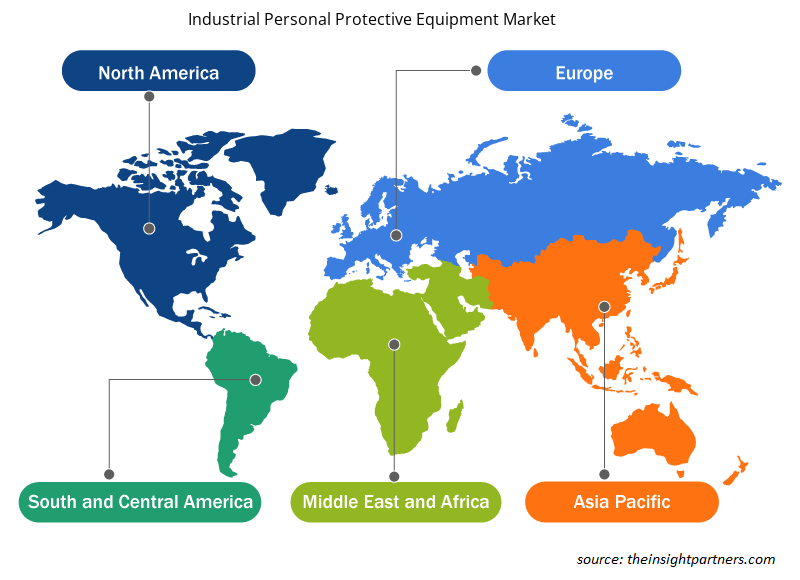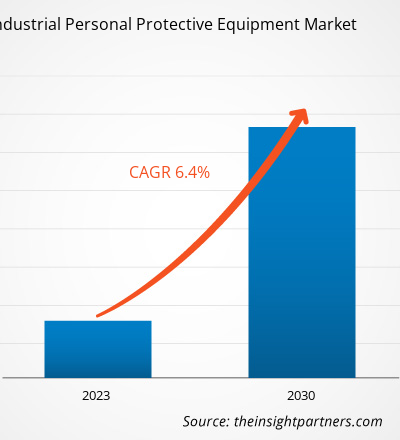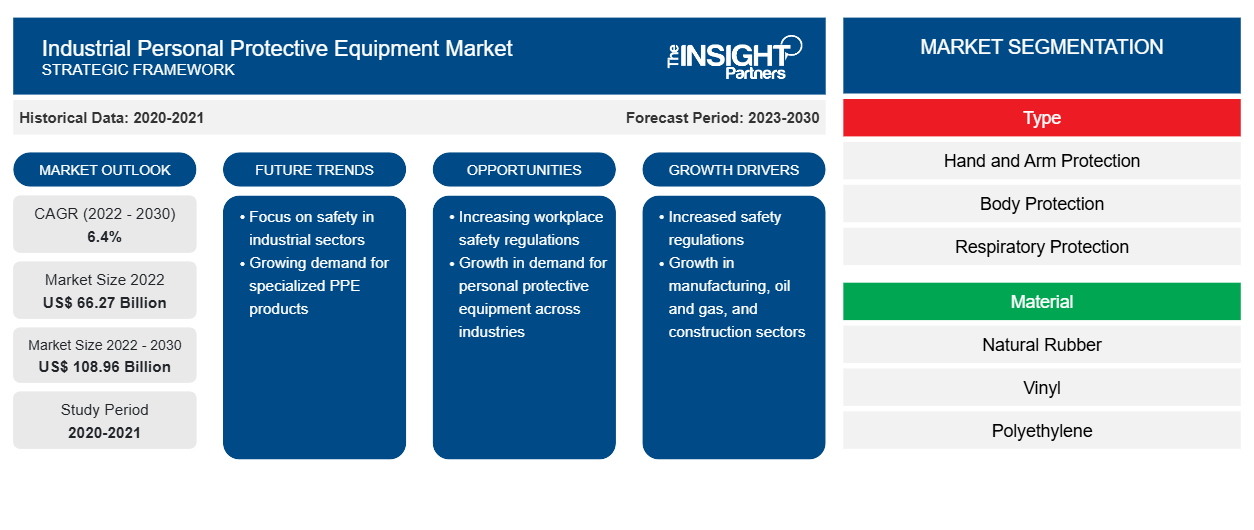[Informe de investigación] El tamaño del mercado de EPP industrial creció de US$ 66.265,71 millones en 2022 y se espera que represente US$ 108.959,51 millones en 2030; a una CAGR del 6,4% de 2022 a 2030.
Perspectivas del mercado y opinión de analistas:
Los equipos de protección personal ( EPP ) industriales incluyen productos utilizados para la seguridad personal en los lugares de trabajo y las industrias pesadas, como el petróleo y el gas, la construcción, la fabricación, los productos químicos, la minería y los productos farmacéuticos. Los EPP industriales comprenden productos como calzado de protección, equipos de protección de manos y brazos, equipos de protección de cabeza y cara, equipos de protección contra caídas y dispositivos de protección auditiva. La creciente conciencia de la seguridad personal en las industrias pesadas donde los trabajadores están expuestos a diversos peligros y accidentes industriales está impulsando el crecimiento del mercado de EPP industriales .
Factores impulsores del crecimiento y desafíos:
Las agencias gubernamentales globales, como la Administración de Seguridad y Salud Ocupacional (OSHA) y la Administración Federal de Carreteras, tienen estándares específicos para usar ropa de alta visibilidad, principalmente para la construcción de carreteras. Estas agencias comúnmente hacen referencia a los estándares de consenso de la industria emitidos por la Asociación Internacional de Equipos de Seguridad y el Instituto Nacional Estadounidense de Estándares. Esto se conoce como el Estándar ANSI/ ISEA 107 o Estándar Nacional Estadounidense para Ropa y Sombreros de Seguridad de Alta Visibilidad . De manera similar, en Europa, la Agencia Europea para la Seguridad y la Salud en el Trabajo ( EU-OSHA ) y la Red Europea de Organizaciones Profesionales de Seguridad y Salud ( ENSHPO ) establecen mandatos sobre los requisitos para el diseño, la fabricación y la distribución de EPP destinados a su uso en el entorno laboral e imponen otros estándares de seguridad ocupacional en industrias como la construcción, la atención médica, el petróleo y el gas, la automoción y la fabricación. Estas organizaciones también han establecido regulaciones que imponen responsabilidades a los fabricantes para garantizar que el EPP destinado a su uso en el lugar de trabajo se pruebe adecuadamente. También se aseguran de que el equipo lleve el marcado CE y cumpla con los requisitos esenciales de salud y seguridad antes de colocarlo en el mercado europeo. Además, según la "Norma de protección respiratoria", 29 CFR 1910.134 de OSHA, es obligatorio que los empleados tengan un programa respiratorio completo. Los trabajadores que usan protección respiratoria deben participar en un programa respiratorio escrito y seguir las pautas de OSHA. Por lo tanto, las regulaciones gubernamentales de apoyo relacionadas con la seguridad ocupacional están impulsando el crecimiento del mercado mundial de EPP industrial .
Personalice este informe según sus necesidades
Obtendrá personalización en cualquier informe, sin cargo, incluidas partes de este informe o análisis a nivel de país, paquete de datos de Excel, así como también grandes ofertas y descuentos para empresas emergentes y universidades.
-
Obtenga las principales tendencias clave del mercado de este informe.Esta muestra GRATUITA incluirá análisis de datos, desde tendencias del mercado hasta estimaciones y pronósticos.
Segmentación y alcance del informe:
Los EPI industriales globales se segmentan según el tipo, el material, la industria de uso final, el canal de distribución y la geografía. Según el tipo, los EPI industriales se segmentan en protección de manos y brazos, protección corporal, protección respiratoria, protección de cabeza y rostro, entre otros. Según el material, los EPI industriales se segmentan en caucho natural, vinilo, polietileno, nitrilo y otros. Según la industria de uso final, los EPI industriales se dividen en fabricación, construcción, petróleo y gas, productos farmacéuticos y otros. Según el canal de distribución, los EPI industriales se segmentan en mayoristas, minoristas nacionales, minoristas regionales y plataformas en línea. El EPP industrial , según la geografía, está segmentado en América del Norte (EE. UU., Canadá y México), Europa (Alemania, Francia, Italia, Reino Unido, Rusia y el resto de Europa), Asia Pacífico (Australia, China, Japón, India, Corea del Sur y el resto de Asia Pacífico), Oriente Medio y África (Sudáfrica, Arabia Saudita, Emiratos Árabes Unidos y el resto de Oriente Medio y África) y América del Sur y Central (Brasil, Argentina y el resto de América del Sur y Central).
Análisis segmental :
Según el tipo, el mercado de EPI industriales se segmenta en protección de manos y brazos, protección corporal, protección respiratoria, protección de cabeza y rostro, y otros. El segmento de protección de manos y brazos tiene una participación significativa del mercado. Los equipos de protección de manos y brazos incluyen guantes, protectores de dedos y cobertores de brazos. Los equipos de protección para manos y brazos son resistentes a cortes, quemaduras y pinchazos. En las industrias alimentaria y farmacéutica, los guantes de goma o látex se utilizan ampliamente para garantizar la seguridad de los alimentos y medicamentos y prevenir la contaminación. En las industrias manufactureras y de la construcción, los guantes de mano y los protectores de brazos protegen a los trabajadores de abrasiones, hematomas y fracturas mientras manipulan maquinaria y herramientas pesadas. En la industria eléctrica, los guantes de goma aislantes protegen contra descargas eléctricas. En la industria química, los guantes y protectores brindan protección contra productos químicos peligrosos y tóxicos. Varias industrias están exigiendo el uso de equipos de protección de manos y brazos para garantizar la seguridad. Este factor está impulsando significativamente el crecimiento del segmento en el mercado de EPI industriales .
Análisis regional:
Según la geografía, el mercado de EPI industriales se divide en cinco regiones clave: América del Norte, Europa, Asia Pacífico, América del Sur y Central, y Oriente Medio y África. El mercado mundial de EPI industriales estuvo dominado por América del Norte; el mercado en esta región se valoró en 21.407,13 millones de dólares en 2022. Asia Pacífico es el segundo mayor contribuyente al mercado, que posee casi el 27% de la cuota de mercado mundial. Se espera que Europa registre una CAGR de ~7% en el mercado de EPI industriales entre 2022 y 2030. El aumento de los casos de lesiones relacionadas con el trabajo y los crecientes requisitos de equipos de protección industrial de alta eficacia y alta calidad en las industrias más importantes, como la fabricación, la construcción, el petróleo y el gas y los productos farmacéuticos, aumentan la penetración del mercado de EPI industriales en la región. Países como el Reino Unido, Alemania y Francia tienen una infraestructura empresarial avanzada, lo que contribuye aún más al crecimiento del mercado. Las tendencias más significativas en este mercado incluyen el desarrollo de accesorios versátiles y ponibles, ropa sostenible y nuevas tecnologías integradas. Desde que estalló la pandemia de COVID-19 en Europa, la legislación para los empleados ha ido evolucionando constantemente y las empresas están cubriendo los gastos de seguridad y salud de sus empleados. El creciente número de obras en Europa y la incertidumbre de la pandemia dieron lugar a una necesidad cada vez más intensa de EPI, lo que impulsó el crecimiento del mercado de EPI industriales en toda la región.
Desarrollos industriales y oportunidades futuras:
- En septiembre de 2019, Vuzix Corporation lanzó las "Vuzix Blade Smart Glasses", un producto con certificación de seguridad para empresas que brinda la protección necesaria para diversas aplicaciones industriales y laborales.
- En agosto de 2021, Gales presentó una colección de calzado EPP inteligente para ofrecer protección y comodidad a los expertos de la industria de la salud.
- En agosto de 2022, Canaria Technologies lanzó Canaria-V, un dispositivo EPI inteligente, portátil y no invasivo que estima las modificaciones en la fisiología del usuario a través de la tecnología de fotopletismografía transmisiva (PPG) y extrae métricas relacionadas con la fatiga cognitiva y el estrés térmico.
Perspectivas regionales del mercado de equipos de protección personal industrial
Los analistas de Insight Partners explicaron en detalle las tendencias y los factores regionales que influyen en el mercado de equipos de protección individual industriales durante el período de pronóstico. Esta sección también analiza los segmentos y la geografía del mercado de equipos de protección individual industriales en América del Norte, Europa, Asia Pacífico, Oriente Medio y África, y América del Sur y Central.

- Obtenga datos regionales específicos para el mercado de equipos de protección personal industrial
Alcance del informe de mercado de equipos de protección personal industrial
| Atributo del informe | Detalles |
|---|---|
| Tamaño del mercado en 2022 | US$ 66,27 mil millones |
| Tamaño del mercado en 2030 | US$ 108,96 mil millones |
| CAGR global (2022-2030) | 6,4% |
| Datos históricos | 2020-2021 |
| Período de pronóstico | 2023-2030 |
| Segmentos cubiertos |
Por tipo
|
| Regiones y países cubiertos |
América del norte
|
| Líderes del mercado y perfiles de empresas clave |
|
Densidad de actores del mercado: comprensión de su impacto en la dinámica empresarial
El mercado de equipos de protección individual industriales está creciendo rápidamente, impulsado por la creciente demanda de los usuarios finales debido a factores como la evolución de las preferencias de los consumidores, los avances tecnológicos y una mayor conciencia de los beneficios del producto. A medida que aumenta la demanda, las empresas amplían sus ofertas, innovan para satisfacer las necesidades de los consumidores y aprovechan las tendencias emergentes, lo que impulsa aún más el crecimiento del mercado.
La densidad de actores del mercado se refiere a la distribución de las empresas o firmas que operan dentro de un mercado o industria en particular. Indica cuántos competidores (actores del mercado) están presentes en un espacio de mercado determinado en relación con su tamaño o valor total de mercado.
Las principales empresas que operan en el mercado de equipos de protección personal industrial son:
- Honeywell Internacional Inc.
- Industrias Lakeland Inc.
- DuPont de Nemours Inc
- Compañía 3M
- Ansell Ltd
Descargo de responsabilidad : Las empresas enumeradas anteriormente no están clasificadas en ningún orden particular.

- Obtenga una descripción general de los principales actores clave del mercado de equipos de protección personal industrial
Impacto del COVID-19:
La pandemia de COVID-19 afectó a casi todas las industrias en varios países. Los confinamientos, las restricciones de viaje y los cierres de empresas en América del Norte, Europa, Asia Pacífico (APAC), América del Sur y Central (SAM) y Oriente Medio y África (MEA) obstaculizaron el crecimiento de varias industrias, incluida la industria de productos químicos y materiales. El cierre de las unidades de fabricación perturbó las cadenas de suministro globales, las actividades de fabricación, los cronogramas de entrega y las ventas de productos esenciales y no esenciales. Varias empresas experimentaron retrasos en las entregas de productos y una caída en las ventas de sus productos en 2020. El mercado de EPI industriales fue testigo de impactos similares de la pandemia.
Durante la pandemia de COVID-19, aumentó la demanda de EPI industriales en algunas industrias, incluida la industria de la salud y el personal de primera línea. Artículos como respiradores N95, protectores faciales y guantes médicos experimentaron un aumento sustancial en la demanda, lo que generó un impacto favorable en el mercado de EPI industriales hasta cierto punto. Además, la demanda de EPI industriales, como guantes, mascarillas y chaquetas protectoras antivirales, aumentó en los laboratorios de investigación involucrados en el desarrollo de vacunas para diferentes variantes del SARS-CoV-2. Con un aumento abrupto de la demanda, los participantes clave de la industria global de EPI industriales aumentaron sus capacidades de producción. Además, para prevenir la propagación de COVID-19, cubrirse la nariz y la boca era obligatorio. Los respiradores N95 fueron los preferidos para controlar la propagación de la enfermedad. Por lo tanto, la demanda de dichos productos aumentó durante la pandemia. Además, con el aumento de casos de COVID-19 en toda la región, la demanda de EPI aumentó en las industrias farmacéuticas y los laboratorios de investigación biomédica.
En 2021, varias economías reanudaron sus operaciones, ya que varios gobiernos anunciaron una flexibilización de las restricciones impuestas anteriormente, lo que tuvo un impacto positivo en el mercado mundial. Además, se permitió a los fabricantes operar a plena capacidad, lo que les ayudó a superar la brecha entre la demanda y la oferta.
Panorama competitivo y empresas clave:
Algunos de los actores destacados que operan en el mercado global de EPI industriales son Honeywell International Inc, Lakeland Industries Inc, DuPont de Nemours Inc, 3M Co, Ansell Ltd, VF Corp, Hultafors Group AB, Aramark, Kimberly-Clark Corp y WL Gore and Associates Inc, entre otros. Estos actores del mercado están adoptando iniciativas de desarrollo estratégico para expandirse, impulsando aún más el crecimiento del mercado.
- Análisis histórico (2 años), año base, pronóstico (7 años) con CAGR
- Análisis PEST y FODA
- Tamaño del mercado, valor/volumen: global, regional y nacional
- Industria y panorama competitivo
- Conjunto de datos de Excel
Informes recientes
Testimonios
Razón para comprar
- Toma de decisiones informada
- Comprensión de la dinámica del mercado
- Análisis competitivo
- Información sobre clientes
- Pronósticos del mercado
- Mitigación de riesgos
- Planificación estratégica
- Justificación de la inversión
- Identificación de mercados emergentes
- Mejora de las estrategias de marketing
- Impulso de la eficiencia operativa
- Alineación con las tendencias regulatorias























 Obtenga una muestra gratuita para - Mercado de equipos de protección individual industriales
Obtenga una muestra gratuita para - Mercado de equipos de protección individual industriales